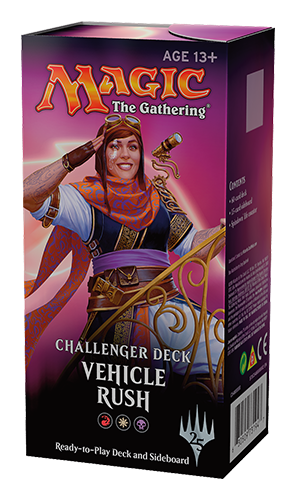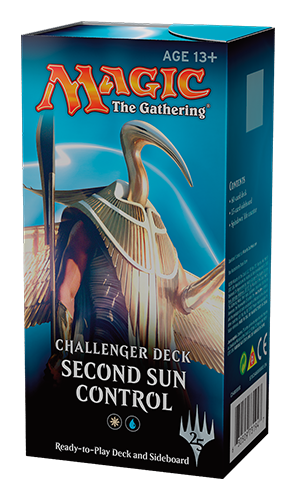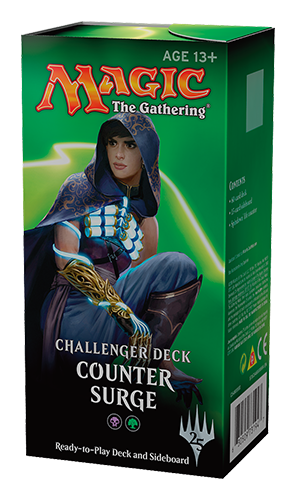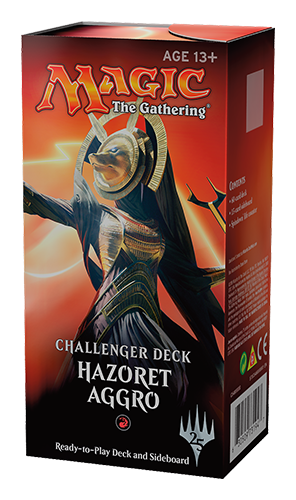Hello there! My name is Kendra Smith, a.k.a. TheMaverickGirl. You might know me for playing Elves in Pauper. In the last few weeks I’ve been trying something different and dipping my feet into Standard. Since I am unfamiliar with the current metagame, I wanted to try something that could give me the opportunity to learn the format and experiment affordably. The answer came neatly in the form of Wizards of the Coast’s amazing new products: the Challenger Decks.
The Challenger Decks, releasing this Friday, April 6, 2018, feature a robust variety of play styles and sought-after cards in them, all for an amazingly priced $29.99 MSRP (though many retailers are charging slightly more for the more value-centric lists). While the Event Decks of yesteryear were barely playable at a Friday Night Magic event, these lists offer a greater representation of true competitive archetypes, all within a very reasonable price point. You can find all four amazing lists on the Mothership here. Over the next few weeks I plan on taking you through how each of these lists fared and ways to upgrade them into true competitive lists on a budget, starting today with a brief overview of each along with its pros and cons.
 My first choice for Magic Online’s Friendly Standard Leagues (often comparable to a FNM in skill level) was the Vehicle Rush deck. I started here because the last time I actively played was shortly prior to the first wave of recent Standard bans on January 9, 2017. So I, like many other long-absent players, have the most familiarity with this list compared to others. The gameplay is traditional Mardu Vehicles to a tee and it showed almost instantly from the moment I started playing with the deck. Your goal is to play small, quick creatures while sticking big vehicles for them to crew and take down your opponent, all the while removing any obstacles in your way of achieving this goal. The deck plays fluidly and contains many core archetype cards; and it is arguably the most complete out of the box package you’ll find with these decks. However, it needs work in areas such as its mana base and sideboard options. In the end, the deck started me out with a surprisingly wonderful 3-2 finish.
My first choice for Magic Online’s Friendly Standard Leagues (often comparable to a FNM in skill level) was the Vehicle Rush deck. I started here because the last time I actively played was shortly prior to the first wave of recent Standard bans on January 9, 2017. So I, like many other long-absent players, have the most familiarity with this list compared to others. The gameplay is traditional Mardu Vehicles to a tee and it showed almost instantly from the moment I started playing with the deck. Your goal is to play small, quick creatures while sticking big vehicles for them to crew and take down your opponent, all the while removing any obstacles in your way of achieving this goal. The deck plays fluidly and contains many core archetype cards; and it is arguably the most complete out of the box package you’ll find with these decks. However, it needs work in areas such as its mana base and sideboard options. In the end, the deck started me out with a surprisingly wonderful 3-2 finish.
 I continued by trying out the Second Sun Control list. This list takes on the classic control archetype by shutting down your opponent’s game plan through the use of counter magic, spot removal, and board wipes, all the while give yourself plenty of card selection to win with the deck’s namesake card, Approach of the Second Sun. While the deck covers the archetype well enough, it unfortunately stumbled into a 1-3 finish before I ultimately dropped. Despite being a solid representation of control in the current Standard environment, the deck has some glaring omissions such as Disallow, while utilizing some more questionable options like Kefnet the Mindful. With just a little improvement, the deck can truly be a force to reckon with, and has performed so well in the metagame for quite a while as a direct result.
I continued by trying out the Second Sun Control list. This list takes on the classic control archetype by shutting down your opponent’s game plan through the use of counter magic, spot removal, and board wipes, all the while give yourself plenty of card selection to win with the deck’s namesake card, Approach of the Second Sun. While the deck covers the archetype well enough, it unfortunately stumbled into a 1-3 finish before I ultimately dropped. Despite being a solid representation of control in the current Standard environment, the deck has some glaring omissions such as Disallow, while utilizing some more questionable options like Kefnet the Mindful. With just a little improvement, the deck can truly be a force to reckon with, and has performed so well in the metagame for quite a while as a direct result.
 While the Second Sun record was slightly disheartening, I pressed on with the black-green Counter Surge list. Your objective here is to land early creatures like Glint-Sleeve Siphoner, Longtusk Cub, and most importantly Winding Constrictor. All three cards offer quick aggressive game plans while also providing plenty of long-term utility in the form of energy, +1/+1 counters, and overall card advantage. This deck looks deceptively straightforward but couldn’t be less so. Cards like the aforementioned Constrictor, Rishkar, Gonti, Walking Ballista, and Verdurous Gearhulk all offer numerous lines of play with your removal and protection spells to take down your opponent. The deck is the most midrange of the set and, like Vehicle Rush before it, went for a smooth 3-2 record. Once again this list suffers from a questionable mana base and a few unusual card choices, such as Hour of Glory, Dispossess, and Slice In Twain, but is largely well-put-together with easily fillable holes.
While the Second Sun record was slightly disheartening, I pressed on with the black-green Counter Surge list. Your objective here is to land early creatures like Glint-Sleeve Siphoner, Longtusk Cub, and most importantly Winding Constrictor. All three cards offer quick aggressive game plans while also providing plenty of long-term utility in the form of energy, +1/+1 counters, and overall card advantage. This deck looks deceptively straightforward but couldn’t be less so. Cards like the aforementioned Constrictor, Rishkar, Gonti, Walking Ballista, and Verdurous Gearhulk all offer numerous lines of play with your removal and protection spells to take down your opponent. The deck is the most midrange of the set and, like Vehicle Rush before it, went for a smooth 3-2 record. Once again this list suffers from a questionable mana base and a few unusual card choices, such as Hour of Glory, Dispossess, and Slice In Twain, but is largely well-put-together with easily fillable holes.
 Finally, I went out with a bang crushing it with the Hazoret Aggro deck. The list is a very strong representation of the classic Red Deck Wins archetype that’s been doing very well in Standard over the course of the last year. The key here is to completely go for the throat with fast evasive creatures and burn spells. Some cards offer more taxing options, such as Harsh Mentor and Soul-Scar Mage, while others offer versatility in how they play, such as Fanatical Firebrand being able to attack or shoot itself away and Bomat Courier getting in for damage and later on refilling your hand with gas. The core of the deck is very strong as presented, though needs some adjustments in sideboard options as well as more copies of Hazoret and Chandra (obviously in minimal amounts here to keep the price down, as even with just one of each, many stores have needed to raise the value of this deck above the others). This deck had the strongest finish with a stunning 4-1 showing.
Finally, I went out with a bang crushing it with the Hazoret Aggro deck. The list is a very strong representation of the classic Red Deck Wins archetype that’s been doing very well in Standard over the course of the last year. The key here is to completely go for the throat with fast evasive creatures and burn spells. Some cards offer more taxing options, such as Harsh Mentor and Soul-Scar Mage, while others offer versatility in how they play, such as Fanatical Firebrand being able to attack or shoot itself away and Bomat Courier getting in for damage and later on refilling your hand with gas. The core of the deck is very strong as presented, though needs some adjustments in sideboard options as well as more copies of Hazoret and Chandra (obviously in minimal amounts here to keep the price down, as even with just one of each, many stores have needed to raise the value of this deck above the others). This deck had the strongest finish with a stunning 4-1 showing.
Overall I was thoroughly amazed with the performance of these decks. To be sure, none of them are the kind of fully realized deck you’d take to a Grand Prix and top 8; but they’re definitely the kind of deck that you can pick up at a good price, play with your friends and at your local shop for smaller events, and use to better yourself as a player. What we’re left with is not just a step up from the Event Decks of old, but one of the best products Wizards has ever put forward.
I’ll be back next week to talk about upgrading the Second Sun Control deck in an affordable manner. In the meantime, I’ll be attending Grand Prix Seattle this upcoming weekend. I hope to see some of you there, maybe even rocking some of these incredible lists.
Kendra has been playing Magic since Urza block and never looked back. Playing a variety of formats and being known for championing Pauper in particular, the Elf Queen can be found hanging out on Twitter as well as streaming on Twitch, always seeking to better the community at large.

